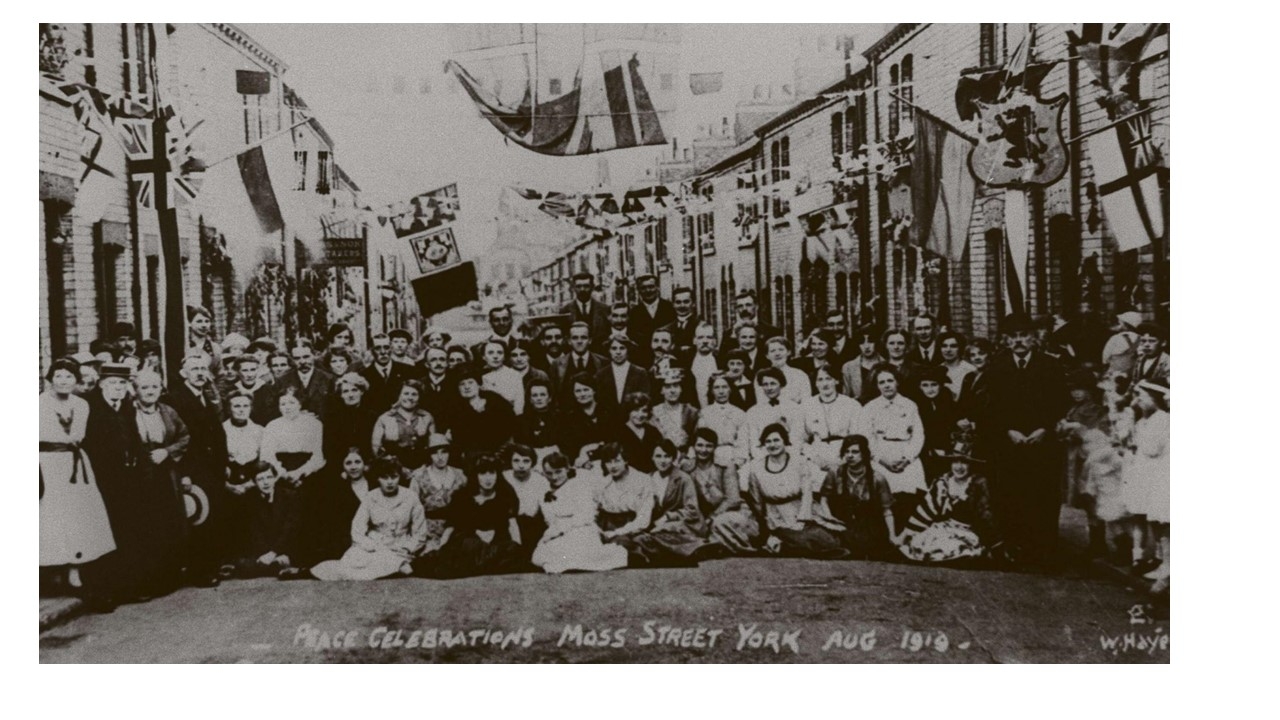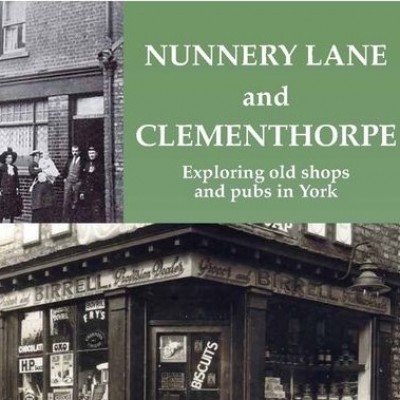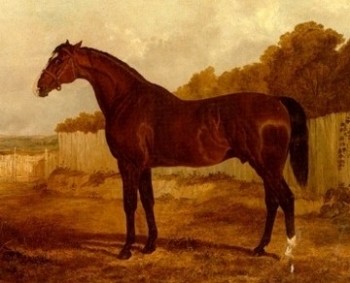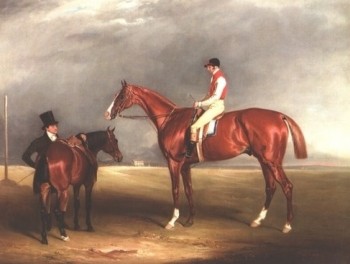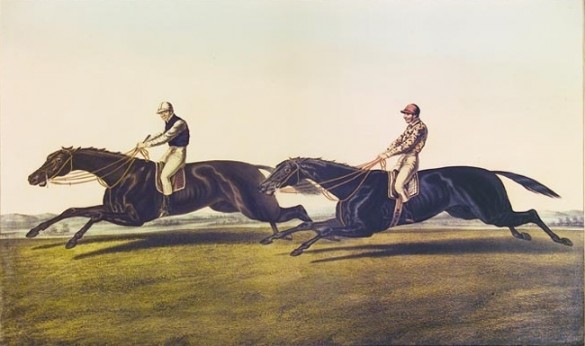The Mosses of Moss Street
One of our members, Peter Thompson, writes:
In researching the history of my own street, South Parade, I became interested in the eponymous Moss family, as the next street along is Moss Street.
Francis Moss Sr was born in 1770, his father probably a publican in Barwick-in-Elmet. In 1807, now in York, he marries Miss Elizabeth Briggs, of York. In 1808 their daughter Sarah is born. In 1812, a son Francis completes the family.
In 1809 he takes over the business in Minster Yard of Thomas Knowles, Coach Master. He purchases new carriages with good horses: A Hearse and Mourning Coach may be had to any part of the kingdom. He also runs a livery stables. By 1816 he is dealing in racehorses. A death notice in the Bolton Chronicle and Blackburn Standard (no less) notes that “he was a most successful breeder of blood-stock and to his stud the turf were indebted for Blacklock, Velocipede and many of our best English racers”.
Blacklock (left) and Velocipede. Two of Francis Moss’s best racers
Blacklock in Landscape by John Frederick Herring. Velocipede, by John Ferneley - encore-editions.com, Public Domain, https://commons.wikimedia.org/w/index.php?curid=22838580
Velocipede sired Voltaire, the grand-sire of Voltigeur, who won both the Derby and St Leger in 1850. That same year he beat The Flying Dutchman in the Doncaster Cup, the only one of his fifteen races that The Flying Dutchman lost. The following year in what became known as ‘The Great Match’ at York, for a purse of 2000 guineas, The Flying Dutchman defeated Voltigeur. The crowd was estimated at between 100,000 and 150,000, the all-time record for York.
The Great Match 1851 by John Herring Sr
Public Domain, https://commons.wikimedia.org/w/index.php?curid=953725
In 1824 Francis Moss becomes a key member of the York Commercial Building Company, a group of local businessmen who have bought:
‘All that close or parcel of land commonly called or known by the name of Nunnery Garth and containing an estimation of 1 acre and 1 rood … adjoining on the lands belonging to Matthew Brown on the East, the King's highway on the West, on land in the occupation of widow Sowdan on the North and on a garden in the occupation of Sam Smith on the South…. Without Micklegate Bar in the suburbs of York and then or late in the tenure or occupation of William Stead.’
On this land between 1824 and 1828 is built South Parade, to the design (probably) of the architect Peter Atkinson Jr, but the history of South Parade is another story.
In 1834, Francis Moss sells the Minster Yard business to George Elliott Lovegrove. It is now a big business, with stabling for 40 horses, coach houses for 30 carriages and granaries for 500 quarters of corn. The following year he retires from the seed trade, selling his business and stock to Richard Hood and Sons, seed merchants of Mint Yard, York.
Two years later, in April 1837, Francis Moss Sr dies at his home in South Parade. He is buried at All Saint's church in Barwick-in-Elmet. In 1839 Elizabeth Moss, his widow, dies aged 69. She joins her husband in All Saint's churchyard.
Around this time, in 1840, there is the beginning of residential development along Blossom Street. Mount Parade was developed from 1823 onwards. By 1840 that Parade was complete. Thomas Rayson, the probable builder of South Parade, built himself a house in Park Street in 1836, today’s no. 7. By 1840 nos. 9 and 11 Park Street had been built. A plot of land of ‘one acre and 4 perches’ (a perch being approximately 25 sq metres) at the bottom of Park Street ‘with extensive frontage towards Scarr Croft’ is auctioned in 1847 and the houses 13 -19 Park Street constructed there by 1850. East Mount Road is not built until the late 1850s, and though Shaw’s Terrace existed in some form in 1861, a terrace of ’18 newly built houses’ in Shaw’s Terrace is reported in 1867. By 1870 there is extensive residential development from South Parade to Park Street, but still no Moss Street.
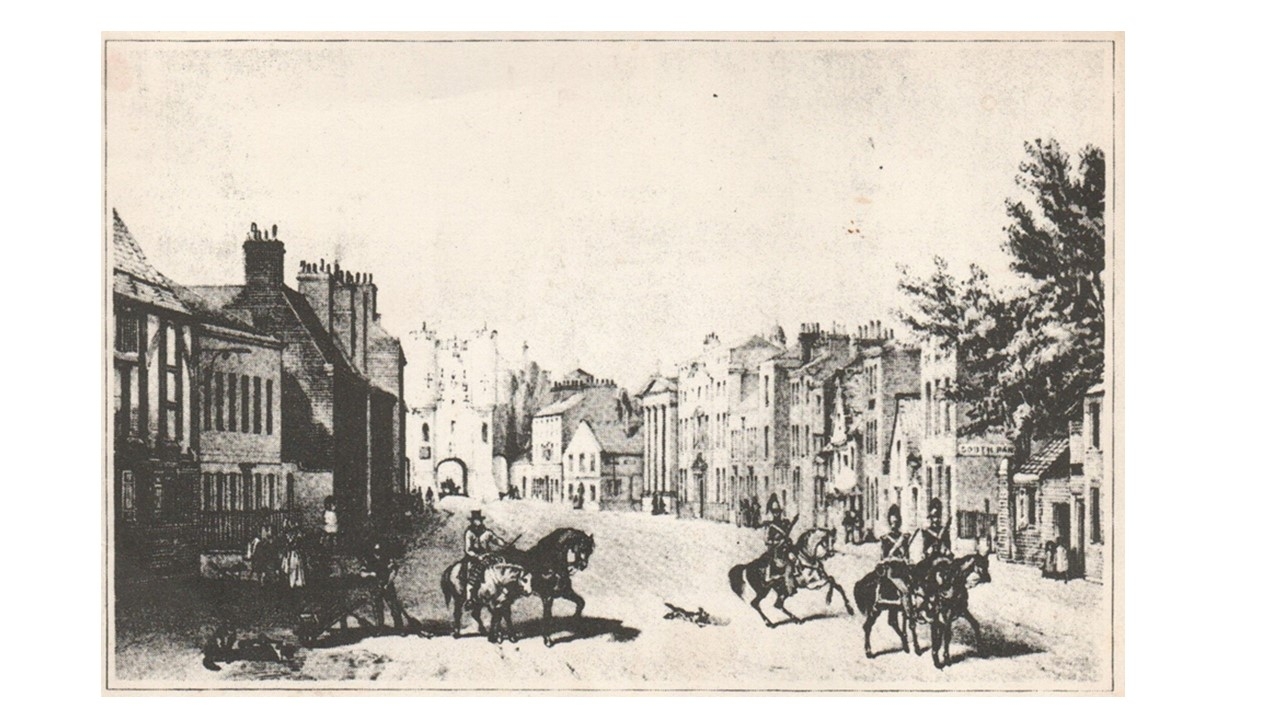 Perhaps the earliest picture of South Parade (just). The street sign ‘South Par’ can be seen on the right. The Bar Convent and its extension built to the design of G.T. Andrews in 1844-45 are clearly visible, putting an earliest possible date on this image.
Perhaps the earliest picture of South Parade (just). The street sign ‘South Par’ can be seen on the right. The Bar Convent and its extension built to the design of G.T. Andrews in 1844-45 are clearly visible, putting an earliest possible date on this image.
To pick up the story we must follow the fates of Francis Moss’s children, Francis Jr and his sister Sarah, following the deaths of their parents.
Young Francis, now living in Union Terrace, off Clarence St to the north of York Minster, appears to have taken over the management of the family’s property in South Parade, of which it appears that Francis Sr had built up a substantial holding. In 1845, no. 1 South Parade is for let by F. Moss, of Union Terrace. In 1851 it is no. 4 for let by F. Moss, still in Union Terrace. In 1854 it is no. 20 for let, but now Francis is living at no. 4 South Parade. The following year it is no. 4 up for rent, apply F. Moss at no. 2. In 1858 a robbery of lead spouting from no. 2 South Parade lists Mr F Moss as the house owner, but that same year no. 2 is up for rent, apply F. Moss at no. 4. The 1861 census lists both Francis and Sarah as living at no. 4 South Parade. But when no. 20 come up for rent later that year, applications are to F. Moss at no. 1! In the 1871 census both brother and sister are at no. 20.,
Over the years it seems that Francis Moss has been renting out nos. 1, 2, 4, 14 and 20 whilst living at nos. 1, 2, 4 and 20. We also know his father held the deeds to no. 16.
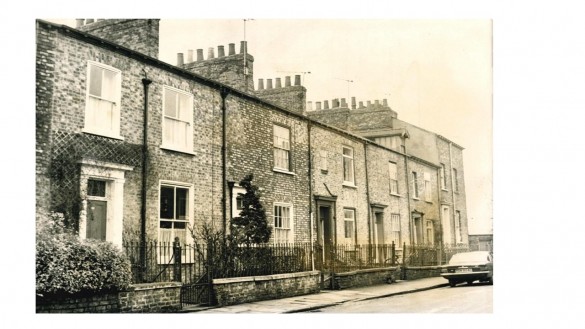
Union Terrace, home of Francis Moss Jr until his move to South Parade in the early 1850s. Much of Union Terrace was controversially demolished in the 1970s, to make way for the Inner Ring Road that was never built. The Ring Road would have possibly demolished much of Moss Street, but that’s another story…
Meanwhile, in September 1840 Sarah Moss, before moving to South Parade, is living in Gillygate and appears to be negotiating for the land south of South Parade, borrowing £370 to help with the purchase. It comprises eight houses fronting Blossom Street, with gardens extending down South Parade to Scarcroft. In total the dimensions are 129 feet by 173 yds, the land on which Moss Street stands today.
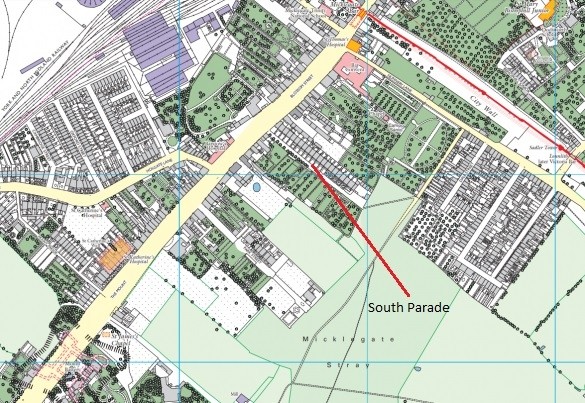 Blossom Street in 1850. The completed Mount Parade is at bottom left and the early houses in Park Street have been built. The houses on Blossom Street and the gardens in front of South Parade, for which Sarah Moss was negotiating can clearly be seen. (Map first published in the Historic Towns Atlas Volume V, © The Historic Towns Trust, 2015 )
Blossom Street in 1850. The completed Mount Parade is at bottom left and the early houses in Park Street have been built. The houses on Blossom Street and the gardens in front of South Parade, for which Sarah Moss was negotiating can clearly be seen. (Map first published in the Historic Towns Atlas Volume V, © The Historic Towns Trust, 2015 )
Tragedy befell the family on 29 April 1875; the following day the Yorkshire Herald carried this report:
“Suicide of a Gentleman by Hanging in York.— Yesterday afternoon Mr. Francis Moss, of South Parade, Micklegate committed suicide by hanging. He was out in the city in the morning, but failed to return to the house of his sister, with whom he resided, to dinner. This circumstance excited suspicion, and between two and three o'clock in the afternoon, the stable adjoining the house was examined, when the unfortunate man was found suspended by a rope which encircled his neck to the ladder communicating with the hay-chamber. He was cut down by one of the men of Mr. Harrison, joiner, of Holgate-Lane, and Mr. Williams, surgeon, was sent for. Life, however, had been extinct for some time. At present nothing is known by which to account for the rash act.”
An inquest was held a few days later in the Bay Horse Inn, Micklegate:
Miss Sarah Moss, the sister of the deceased, deposed that he went out between ten and eleven o'clock on Thursday morning, and that as he did not return at half-past, and as the stable door of which the key was missing was locked, she went to Mr. Harrison's, joiner, of Holgate-lane. A man of his (Robert Gamble) returned with her and broke the stable door open, and this person deposed to finding the deceased hanging by a rope from a ladder leading to the hay-chamber, and dead, Miss Moss added that the deceased had at times been considerably depressed since the last municipal election for Micklegate Ward, over which he became excited. Gamble found the stable door key in the pocket of the deceased, and saw him at half- past nine o'clock in the morning, when he failed to notice anything particular in connection with him.
P.C. Dean deposed to finding a half-sovereign and 4£d. in money upon the deceased, as well as a bottle containing laudanum. The latter he discovered the deceased had obtained from Mr Oglesby, druggist, of Micklegate, on the representation that he could not sleep, and the instruction that he was to take a dose of ten drops. — Mr. Henry Cowling, solicitor, of York, a trustee under the will of the deceased's father deposed that on the 19th of April he noticed a marked change in the deceased. He did not talk to him (witness) as he had usually done. He did not reply to questions, and he seemed in a low depressed state. This was the whole of the evidence taken, and the jury returned a verdict to the effect that the deceased committed suicide whilst labouring under a fit of temporary insanity.”
So what had been the result of the Micklegate municipal elections earlier in 1875?
Municipal elections in the Micklegate Ward seem to have been gentlemanly affairs for the most part. In the November 1874 election, when two vacancies for the City Council arose, there were two candidates, Mr Thomas Coning and Mr Richard Letby, generally supported by all. However at the last moment a Mr Bellwood, a Conservative, was nominated by Mr Edward Rooke. This would require an election that influential members of the Conservative party did not want, and he would not have received their support. Knowing Mr Coning was physically unfit to ‘go through the harness of a contest’, Joseph Rowntree, a Liberal, spoke to members of the Conservative Party, including Mr Rooke, to induce Bellwood to withdraw, which he did.
However in February 1875 another vacancy arose. Mr E.T. Wilkinson, a draper, was nominated and Mr Bellwood, stood against him, and this time he did not withdraw. The ensuing contest was acrimonious and became very ‘political’, with Mr Wilkinson supported by the Liberals and Mr Bellwood the Conservatives. Mr Wilkinson’s supporters included Joseph and Henry Rowntree and George Leeman, then MP for York.
On 11 February, two days before polling, the papers reported that the fight for the seat has grown ‘hot and furious’. Many handbills and cartoons had been distributed. One for the Liberals showed Mr Wilkinson driving a high-bred and well-conditioned animal in a trap laden with parcels endorsed “Education”, “Intelligence” and “Progress” …in front of a poor lean-conditioned brute urged on by his competitor Mr Bellwood and the load labelled “Gin and Bitters”, “Combs” and “Parchment”.
George Leeman was clearly a high profile supporter of Mr Wilkinson, and the Conservatives felt that he should not be interfering in the election, as he was an Alderman and MP, and that he had tried to influence and intimidate the workers of the North-Eastern Railway Company (of which he was Deputy Chairman at the time) to vote for Wilkinson. A handbill making this accusation had been circulated. Mr Rooke clearly agreed with the handbill, but he denied authorship – to which Leeman responded “it makes very little difference to the arrival of the engine whether you drive the engine or stoke the fire.”
Rooke claimed in one election meeting that before the previous November’s election, Joseph and Henry Rowntree together were prepared to go on their knees asking him, Rooke, to use his influence to get Bellwood to withdraw his nomination. This was denied by Joseph Rowntree, in a letter to the Yorkshire Herald on 11 February.
The outcome of the election was a resounding victory for Mr Wilkinson, with 929 votes to Bellwood’s 713. It was clearly a bitterly fought election and one can only assume that Francis Moss Jr was a staunch Conservative and extremely disappointed by the result.
But could this result really have led Francis to commit suicide two months later?
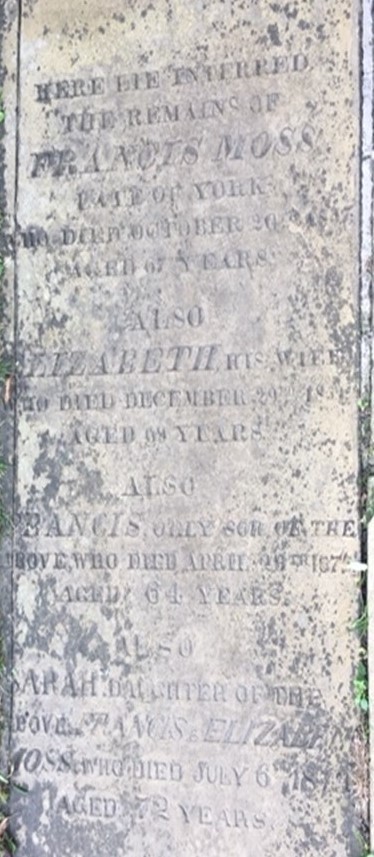 Despite the suicide, Francis Jr is buried with his parents in All Saint's Barwick-in-Elmet. Before 1823, suicides were traditionally buried at a crossroad, but an Act in 1823 permitted private burials in a churchyard, but only at night and without a Christian service. This would have been Francis’s fate. Burial for suicides in daylight was only permitted after the Act of 1882.
Despite the suicide, Francis Jr is buried with his parents in All Saint's Barwick-in-Elmet. Before 1823, suicides were traditionally buried at a crossroad, but an Act in 1823 permitted private burials in a churchyard, but only at night and without a Christian service. This would have been Francis’s fate. Burial for suicides in daylight was only permitted after the Act of 1882.
In 1876, the year after her brother’s death, Sarah Moss makes her will. She is clearly a wealthy woman, having inherited much from her father. Several people are to receive gifts of £50, including her servant, Anne Lang, and a Mr Elder of Mount Vale, described as ‘my dear brother’s constant friend’.
She names two co-heirs, Francis Moss Todd (described as an infant by Matthew Todd his guardian ‘ad litem’) and James Moss Wiggins. Who these two are remains largely a mystery, although Francis Moss Todd goes on to be a successful auctioneer, living in 38 Bishopthorpe Road and later at 9, Vine Street. However, they are very lucky. Sarah Moss’s estate includes five freehold houses and a stable in South Parade, all inherited from her father, and seven freehold cottages in Blossom Street, with gardens behind, fronting South Parade. She stipulates that the gardens are not to be built on, perhaps the reason why Moss Street is built so long after neighbouring roads.
Sarah Moss survived her brother by just four years, dying on 9 June 1879. After her brother’s death she had moved back to no. 4 South Parade. She too is buried in All Saint's church.
By the 1881 census, both No 4 and no. 20 South Parade are listed as uninhabited.
Execution of the will does not go smoothly. In April 1884, in the Chancery Division of the High Court, two plaintiffs, Francis Morritt and John Walter, claim that money borrowed by Sarah Moss to acquire the sole ownership of the land south of South Parade had not been repaid, including the £370 borrowed in 1840.
In 1884, and sadly for the present residents of South Parade, Sarah Moss’s stipulation in her will, that the gardens south of South Parade should not be built on, is overturned by the Court.
By now the debts appear to have been paid and Francis Moss Todd acquires all the land at issue. In 1887 he sells a small plot to Anthony Scott, a builder, on what is now called ‘Moss Street’. Advertisements in the Yorkshire Gazette that year list ‘valuable freehold building sites, being the garden ground fronting South Parade, intended for new street to be called "Moss Street," situate off Blossom Street, in the City of York.’
A year later, in 1888 an advertisement in the Yorkshire Gazette lists ’cheap, TWO HOUSES, in Moss Street, Blossom Street.’
